Table of Contents
Friends, not only the scientists of the world but also the general public, are always curious about Lonar Lake in Maharashtra, India. That is why in this blog post, we will try to explain the information about this lake, what exactly caused the lake to be formed, etc. Let’s start reading this beautiful blog post on how Lonar Lake was formed without wasting too much time.
Lonar Lake is also known as Lonar Crater. It was thought initially, that it originated about 50,000 to 52,000 years ago. But more research has been done on this in recent times. Researchers have now confirmed that it originated about 5,70,000 (0.57 Million) years ago. You can read more about it, in the history of Lonar Lake blog post.
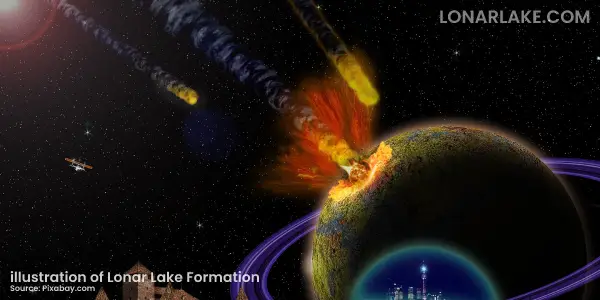
Lonar Lake is one of the most beautiful lakes in India and is formed when a large meteorite fell onto the earth. We know that you will now have a lot of questions on your mind about the meteorite which was the reason for forming Lonar Lake. So let’s try to find out the answers to all these questions.
Types of Space Materials that Fall into Earth
There can be so many types of materials that fall into the earth’s surface, sometimes it could be the pieces the things that were sent into space by humans for research purposes. This unnatural and unused space junk material is called orbital debris.
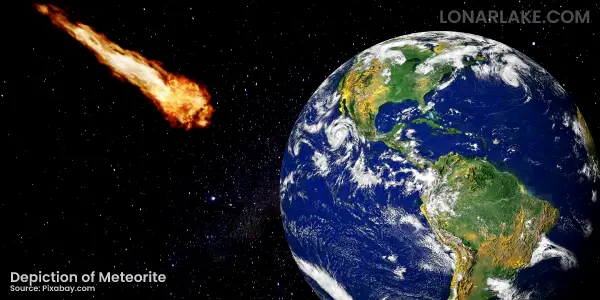
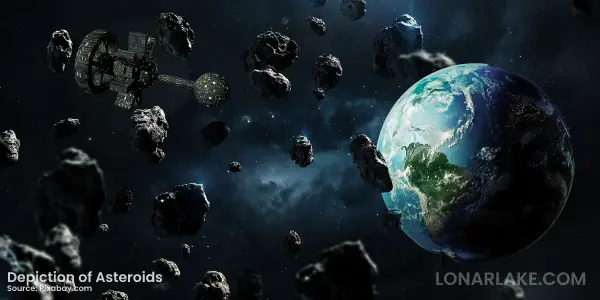
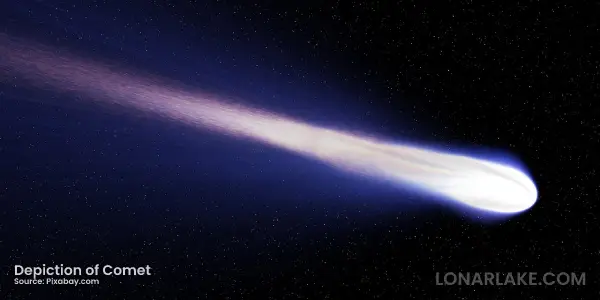
But now let’s discuss the natural space materials that could cause the crater-like structure on the planet. Following are the important types.
- Comets
A few small pieces are made of stone, clay and metal and covered with ice that orbits the sun. As they move closer to the sun, the sun’s temperature causes their ice to suddenly evaporate. And that’s why as they move forward, they see a shiny trail of steam behind them. Such fragments are called ‘comets’ or ‘comet’. - Asteroids
As we know that there is a lot of rocky material available between Mars and Jupiter. This is known as the asteroid belt. Meteors that hit Earth or other planets are probably from this belt. These large bodies are called asteroids. - Meteorites
Small and large pieces of rock and metal or satellites that revolve around the planets in the solar system. Sometimes they get pulled by the planet, due to its gravitational force. At that time, they collided with the planet very fast and made a big impact on the surface of that planet. These materials are called ‘meteorites’ or ‘meteors’.
So, now if you understand the difference between comets, asteroids, and meteorites. Let’s find out more about the meteor that caused Lonar Lake’s formation.
How Lonar Lake was formed and which Meteorite that caused the Lonar Crater.
You must have seen shooting stars in the sky at night and asked for your heart’s desire, right? But if you know the science behind this, you know the fact that these broken stars are nothing more than meteorites.
Many of these meteorites get pulled to Earth by Earth’s gravity. They strike the earth with great speed and tremendous energy. And some of the largest meteorites of this type have created huge craters or lakes on our planet. Lonar Crater is the third largest meteorite crater in the world and the largest in India.
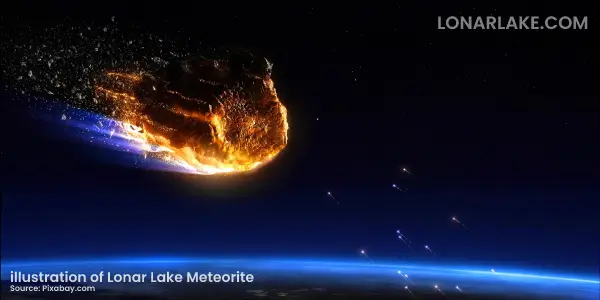
It is found that the meteorite that hit Lonar, India was a huge piece of meteorite. When it was approaching Earth, it was shattered by the friction and heat of the Earth’s atmosphere, and from those shattered pieces a large piece fell near Lonar City, India. Whereas other pieces also fell in the surrounding area but with no significant impact.
It is not only Lonar, India on earth that has a meteor shower. If you don’t know, you’ll be surprised to read that, by NASA research, there are about 200 known meteorite cracks all over the earth so far. So we can imagine that meteorites are always falling on the earth.
How many meteors hit Earth daily?
The meteor shower has caused a lot of changes on earth so far. But did you know that meteor showers happen every day in the entire universe and even on our mother planet Earth? You may get surprised, but it’s true!
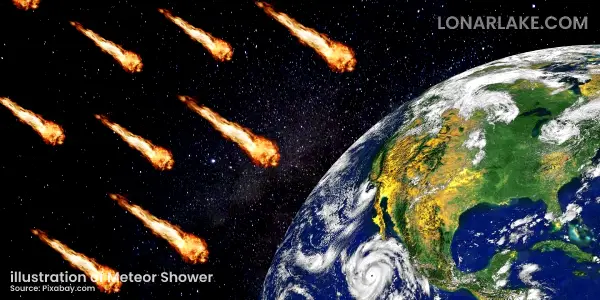
Approximately 25 million meteorites, micrometeoroids, and many other rocks and debris from space enter Earth’s atmosphere every day. And about 30,000 to 1.5 million meteorites enter our Earth’s atmosphere each year. And that means about 15,000 tons of material enters our Earth’s atmosphere every year.
This huge amount of waste gets pulled by our earth. But thanks to the atmosphere and magnetic field around the earth, it burns and destroys meteorites on their way before it falls into the earth.
How big was the asteroid that killed the dinosaurs?
You know that meteorites are always falling somewhere in the universe. And these meteorites are constantly changing the entire universe. Earth has experienced such large amounts of meteor showers. And these meteorites have caused a lot of chemical, biological, geographical changes on earth. And similar meteorites have wiped out dinosaurs from our planet.
According to scientists, the type of meteorite that destroyed dinosaurs from Earth was approximately 7.5 miles (12 kilometers) in diameter. And it hit the earth at a speed of about 27,000 miles, or 43,000 km per hour. And for the same reason, a 124-mile (200 km) crater formed on our Earth’s surface, according to research at the University of Texas Institute for Geophysics.
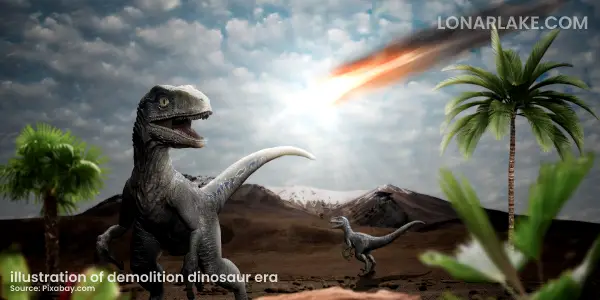
You will be surprised to know that the eruption of a meteorite comes from thousands of kilometers away and with a diameter of only a few kilometers on a planet like Earth. Hits like thousands of nuclear bombs, or atomic bombs, explode together.
They produce much more energy than the energy released by a single thunderstorm. From this, we can imagine a meteor falling somewhere. Now you must be wondering, how dangerously such a meteorite could have destroyed the great dinosaurs that existed on Earth thousands of years ago!
When was the last meteor that hit Earth?
To date, January 2022, the last known meteor shower may have been 66 million years ago (66 million) by a meteor with a diameter of 10 km (6 miles) or more. And for the same reason, Cretaceous-Paleogene became extinct.
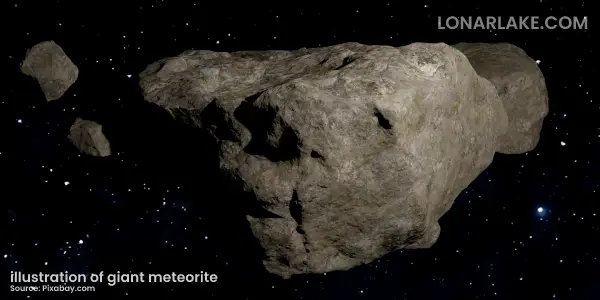
What’s the biggest asteroid to hit Earth?
The meteorite at Lonar, India is not only the largest meteorite in the world, but there are many more meteorites larger than that of Lonar. The Chelyabinsk meteor is the largest recorded natural meteorite to hit Earth since the 1908 Tunguska incident.
The meteorite landed in the southern Ural region of Russia on February 15, 2013. The meteorite is approximately 17-20 meters (66 ft) in diameter and weighs approximately 10,000 tons. The meteorite caused extensive damage to Siberia’s natural resources and forests. The meteorite is estimated to have caused more than $30 million in damage.
According to a study by NASA, the Vredefort Crater or Vredefort Dome in South Africa is the world’s largest, number one meteorite crater. This crater extends for about 180 to 300 KM.
Citation
At last, we just want to know if you found this information useful then please let us know by commenting below. Your comment encourages us to do more and bring you such informative materials for you. You can show your support by following our Lonar Lake Facebook page.

![Latest News About Lonar Lake [Crater] 17 Latest News About Lonar Lake](https://lonarlake.com/wp-content/uploads/2022/02/Latest-News-About-Lonar-Lake-Featured-Image-510x510.jpg)


